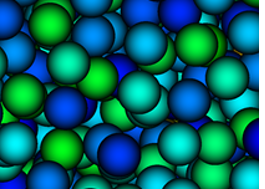The correct representation of bulk materials depends on many factors, one of which is the particle shape. In many cases, spheres with additional physical properties (e.g., rolling friction) are a good choice, but often also nonspherical particles are used. Aspherix® offers a wide range of them, comprising multispheres, flexible, bonded particles, superquadrics (tablets, boxes, cylinders, …) and also triangulated objects.

Many bulk materials can be represented by spheres, particularly when using physical models such as rolling friction or cohesion.

Investigation of the shape effect in an emptying hopper. On the left hand side, a polydisperse packing of spheres is considered, while the bulk material on the right hand side consists of multisphere particles.

By loading the video, you agree to Vimeo's privacy policy.
Learn more
In Aspherix®, fibers are modelled as multi-sphere bodies with elast-damping interparticle forces (normal and tangential). In this case, grass, modelled by fibers, is bended by a rotating wheel. After being bent, the fibers tend to move back to their original configuration due to the interparticle forces.

By loading the video, you agree to Vimeo's privacy policy.
Learn more
Bonded particles can be used to generate custom shapes like pellets, ellipsoids etc. The mechanical properties of the assemble depend on the bond breakage criterion, normal and tangential stiffness of the bonds, energy dissipation of the bonds and properties of the spherical particles.

By loading the video, you agree to Vimeo's privacy policy.
Learn more

By loading the video, you agree to Vimeo's privacy policy.
Learn more
This video shows a flexible membrane that consists of spherical particles. This is a specific application case of a cohesion model.

By loading the video, you agree to Vimeo's privacy policy.
Learn more
Filling and emptying of a cylinder with superquadric particles.

By loading the video, you agree to Vimeo's privacy policy.
Learn more
Simulation with A and X shaped particles in a rotating drum. The usage of concave particles allows for an accurate representation of the bulk material.

By loading the video, you agree to Vimeo's privacy policy.
Learn more

By loading the video, you agree to Vimeo's privacy policy.
Learn more
Description
Real convex shapes without inward facing components can be imported easily from 3D CAD files.
CATEGORY
Complex shapes
COMBINED WITH
SPH, FEA, MBD, Wear
C++ API
Yes

Description
Shape effect – multispheres vs spheres:

By loading the video, you agree to Vimeo's privacy policy.
Learn more
Description
In Aspherix™, fibers are modelled as multi-spheres bodies with elasto-damping interparticle forces (normal and tangential).
Rolling wheel on grass
In this video, the grass leaves, modelled as fibers, are bended by a rotating wheel. After being bent, the fibers tend to move to their original configuration due to the interparticle forces.

By loading the video, you agree to Vimeo's privacy policy.
Learn more
Bonded particles can be used to generate custom shapes like pellets, ellipsoids etc. The mechanical properties of the assemble depend on the bond breakage criterion, normal and tangential stiffness of the bonds, energy dissipation of the bonds and properties of the spherical particles.

By loading the video, you agree to Vimeo's privacy policy.
Learn more

By loading the video, you agree to Vimeo's privacy policy.
Learn more
This video shows a flexible membrane that consists of spherical particles. This is a specific application case of a cohesion model.

By loading the video, you agree to Vimeo's privacy policy.
Learn more
Filling and emptying of a cylinder with superquadric particles.

By loading the video, you agree to Vimeo's privacy policy.
Learn more
Prismatic spouted bed – simulation with triangulated particles.

By loading the video, you agree to Vimeo's privacy policy.
Learn more